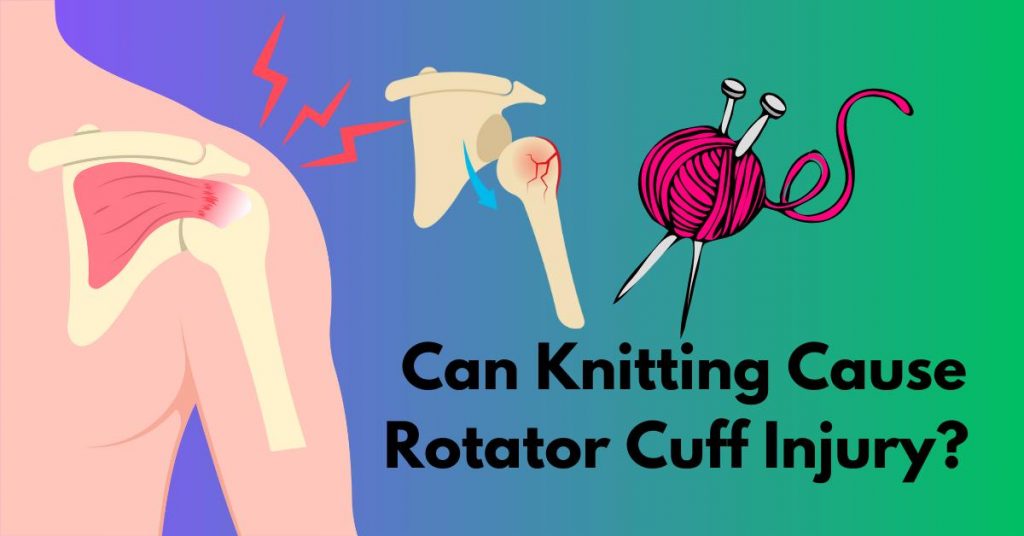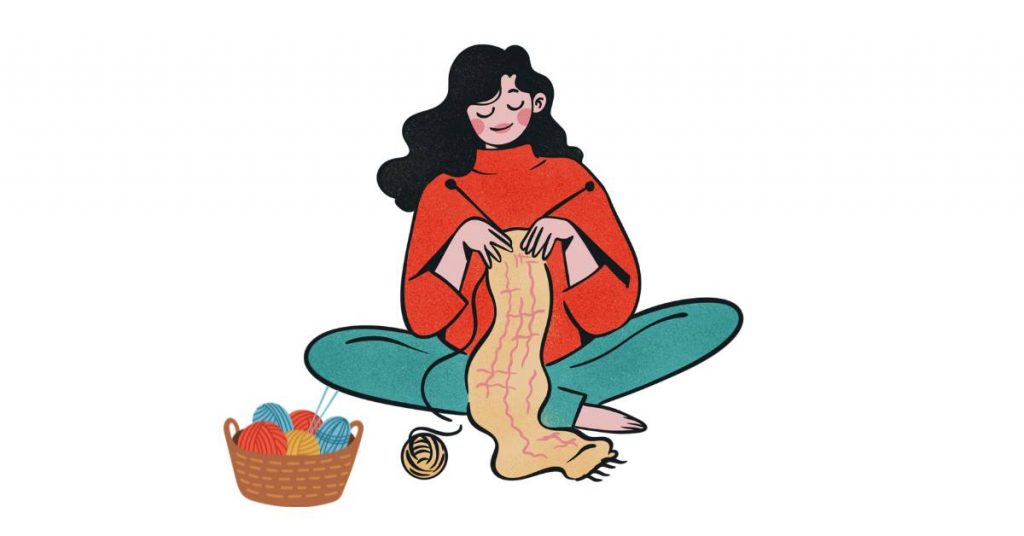Can Knitting Cause Rotator Cuff Injury?

Can Knitting Cause Rotator Cuff Injury? Knitting is a popular hobby, but it can also put your rotator cuff at risk. Learn more about the risks of rotator cuff injury from knitting and how to protect yourself.

Millions of people worldwide enjoy knitting as a popular and relaxing hobby. However, knitting can lead to rotator cuff injuries like any repetitive activity.
This article will explore the relationship between knitting and rotator cuff injuries, investigate the underlying causes, provide preventive measures to mitigate the risk, and offer tips for maintaining healthy knitting practices.
Section 1: Understanding the Rotator Cuff and its Function
The rotator cuff is a group of muscles and tendons surrounding the shoulder joint, providing stability and allowing for a wide range of motion. It plays a crucial role in various activities involving the shoulder, including knitting. Any damage or injury to the rotator cuff can significantly impact shoulder function and cause pain and discomfort.
Section 2: The Relationship Between Knitting and Rotator Cuff Injuries
1. Repetitive Motion:
Knitting involves repetitive shoulder and arm motion, particularly during the repetitive reaching, lifting, and pulling motions required to manipulate yarn and needles. Over time, this repetitive strain can lead to inflammation and wear and tear on the rotator cuff tendons, increasing the risk of injury.
2. Prolonged Posture:
Maintaining the same knitting posture for extended periods, such as hunching over or holding the arms in an elevated position, can strain the muscles and tendons around the shoulder. This sustained stress can contribute to the development of rotator cuff injuries.
3. Poor Technique and Ergonomics:
Incorrect knitting techniques, improper use of knitting tools, and inadequate ergonomics can all contribute to the risk of rotator cuff injuries. The poor technique may involve excessive tension, tight gripping, or awkward movements that place undue stress on the shoulder joint and rotator cuff.
Section 3: Preventive Measures and Healthy Knitting Practices
1. Proper Technique:
Learning and using proper knitting techniques can help reduce the strain on the shoulders and minimize the risk of rotator cuff injuries. Maintaining relaxed shoulders, taking breaks, and using appropriate tension can alleviate stress on the rotator cuff.
2. Ergonomic Considerations:
Choosing knitting tools that are ergonomically designed, such as lightweight needles with cushioned grips, can enhance comfort and reduce strain on the shoulders. Additionally, using supportive seating and maintaining proper posture while knitting can help minimize the risk of injury.
3. Stretching and Strengthening Exercises:
Regular stretching and strengthening exercises for the shoulders and rotator cuff muscles can improve flexibility and resilience. Simple exercises like shoulder rolls, arm circles, and gentle stretches can help alleviate tension and reduce the risk of injury.
4. Rest and Breaks:
Regular breaks during knitting sessions allow the shoulder muscles and tendons to rest and recover from repetitive strain. Setting a timer or incorporating rest periods into knitting projects can help prevent overuse and reduce the risk of rotator cuff injuries.
Section 4: Seeking Medical Attention and Treatment
If you experience persistent pain, discomfort, or limited range of motion in your shoulder while knitting or engaging in other activities, it is important to seek medical attention. A healthcare professional can assess your condition, provide an accurate diagnosis, and recommend appropriate treatment options, including physical therapy, medication, or surgery in severe cases.
Final Verdict
While knitting is a beloved pastime, it is essential to be mindful of the potential risks associated with repetitive activities like knitting, including rotator cuff injuries.
By adopting preventive measures, practicing healthy knitting techniques, and seeking medical attention when necessary, knitters can minimize the risk of rotator cuff injuries and continue to enjoy their craft. Remember to prioritize proper technique, incorporate ergonomic considerations, engage in stretching and strengthening exercises, and take regular breaks to ensure the health and well-being of your shoulders.
By promoting awareness of the potential risks and providing guidance on preventive measures, we can empower knitters to maintain healthy knitting practices and reduce the likelihood of rotator cuff injuries. Remember, knitting should be a joyful and relaxing activity, and with the right approach, it can be enjoyed without compromising shoulder health.
FAQs
Q: How do I know if I have damaged my rotator cuff?
Ans: Determining if you have a damaged rotator cuff involves recognizing certain signs and symptoms. These can include persistent shoulder pain, especially when reaching or lifting, weakness in the affected arm, difficulty with overhead movements, limited range of motion, clicking or popping sensations, and pain during sleep. If you experience any of these symptoms, seeking a medical evaluation for an accurate diagnosis is important.
Q: What activities cause rotator cuff injuries?
Ans: A variety of activities can result in rotator cuff injuries. Common culprits include repetitive overhead motions like throwing, swimming, or painting. Heavy lifting activities, particularly with poor technique, can also damage the rotator cuff. Additionally, traumatic events such as falls or accidents can result in acute injuries to the rotator cuff.
Q: What is the best position to sit while knitting?
Ans: Sitting in a chair with good back support is recommended to maintain a comfortable and ergonomic position while knitting. Keep your back straight and aligned, avoiding slumping or hunching over your work. Position your feet flat on the floor to maintain stability. Adjust the height of your chair and table so that your arms are at a comfortable level and your shoulders are relaxed. Good lighting is also important to prevent strain on your eyes and neck.
Q: Is a rotator cuff injury permanent?
Ans: The extent and severity of a rotator cuff injury will determine its long-term impact. While some minor injuries may heal with conservative treatments like rest, physical therapy, and medication, more severe or chronic injuries may require surgical intervention. Consulting a healthcare professional for an accurate diagnosis and appropriate treatment plan is important. With proper care and rehabilitation, many individuals can recover from rotator cuff injuries and regain normal shoulder function.
Q: What exercises prevent rotator cuff injuries?
Ans: Engaging in specific exercises can help strengthen the rotator cuff muscles and reduce the risk of injury. Some beneficial exercises include external and internal rotation using resistance bands, scapular stabilization, shoulder abduction, adduction, and range of motion exercises. It is important to perform these exercises correctly and consult a healthcare professional or physical therapist to ensure proper form and progression.
Q: What not to do when knitting?
Ans: Avoiding certain practices to prevent strain and discomfort while knitting is important. Firstly, avoid sitting or knitting in awkward positions for prolonged periods. This can lead to muscle tension and fatigue. Secondly, do not grip the needles or yarn too tightly, as excessive tension can strain the hands and wrists. Avoid excessive force or repetitive movements that may put undue stress on the shoulders and wrists. Take regular breaks, stretch your muscles, and listen to your body's cues to prevent overuse injuries.
Following these guidelines, you can better assess and address potential rotator cuff damage, make informed choices during knitting activities, and take proactive measures to prevent and manage shoulder pain or injuries.

Recommendation